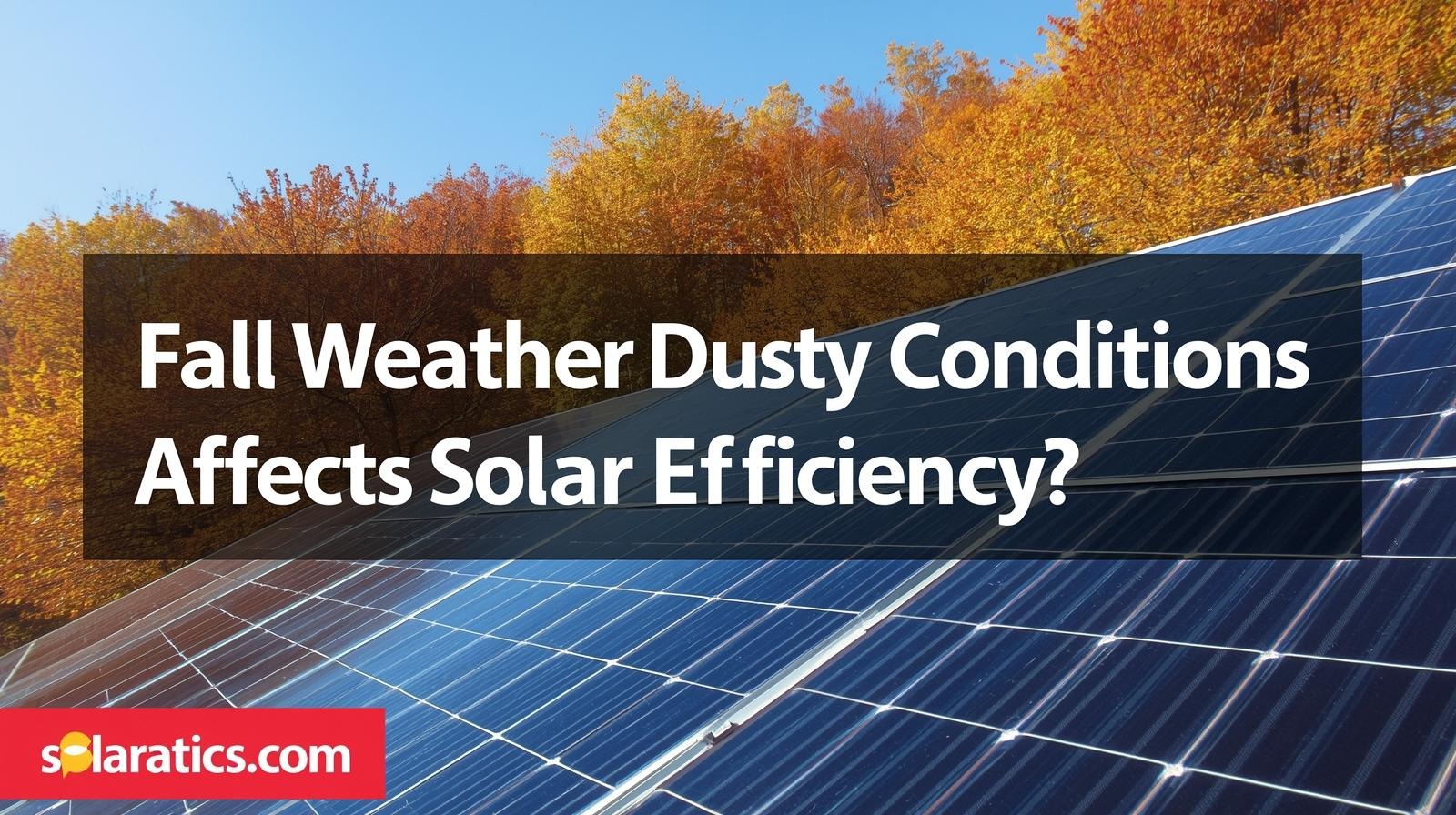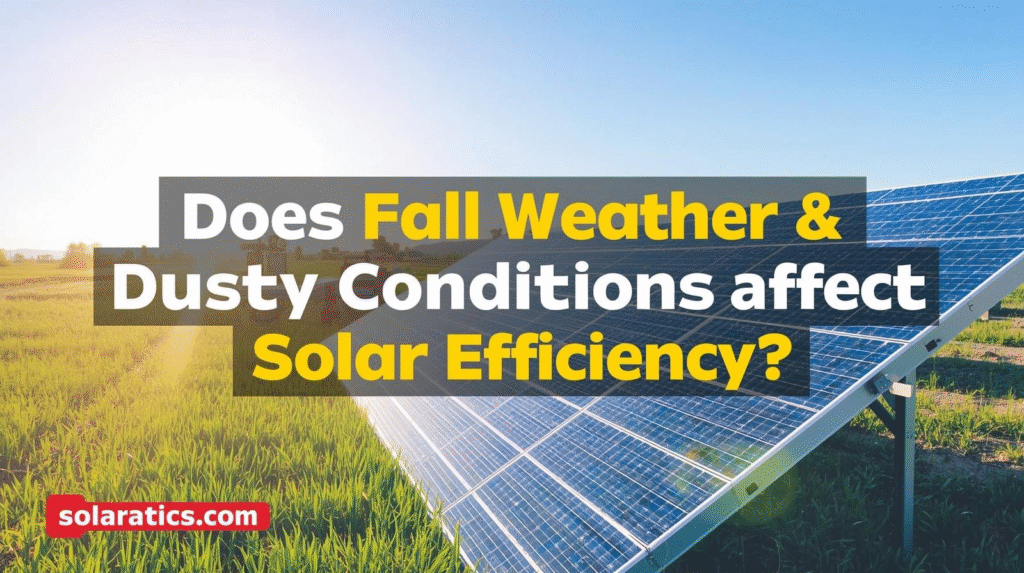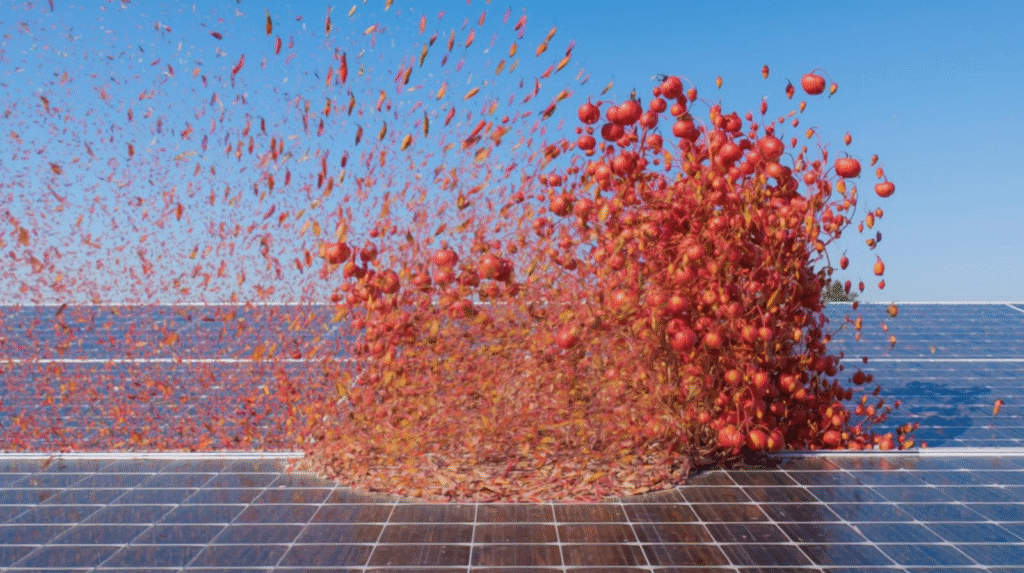Does Fall Weather & Dusty Conditions Affects Solar Efficiency?

Explore how fall weather and dusty conditions affect solar panel efficiency. Learn practical tips to maintain solar output during October.
Introduction (fall weather and dirty conditions)
As autumn arrives, many solar panel owners wonder: Does fall weather and dusty conditions affect solar output in October? Understanding the interaction between seasonal weather and environmental factors like dust is essential for maintaining efficient solar energy production. This comprehensive guide breaks down how fall weather impacts solar panel performance, the role of dust accumulation, and effective strategies to optimize solar output during the autumn months.
Fall Weather Impact on Solar Panels

In October, solar panels face a natural decline in energy production compared to summer months due to shorter daylight hours and the sun’s lower angle in the sky. The reduction in sunlight available results in approximately 20% to 35% less solar irradiance reaching panels. However, cooler temperatures in fall can help solar panels operate more efficiently since they typically perform better in mild conditions compared to extreme heat [fall weather impact on solar panels][solar panel efficiency in autumn].
How Fall Weather Influences Solar Panel Efficiency
Temperature Changes in October
Solar panels, particularly photovoltaic (PV) systems, actually work better in cooler weather.
High summer heat often causes panels to overheat, resulting in a 10–25% drop in efficiency.
By contrast, the crisp October air keeps panels cool, allowing them to generate more electricity per unit of sunlight.
- Cooler fall temperatures can actually improve solar panel efficiency compared to hot summer days.
- Photovoltaic (PV) cells operate better in mild weather, producing more electricity per unit of sunlight.
Reduced Sunlight Hours
This reduction in daylight hours means that even if efficiency per hour is higher, the total daily solar output decreases compared to summer.
- In summer, some areas get 14–15 hours of daylight.
- By October, this drops to 10–11 hours, depending on latitude.
- In October, the days become shorter.
- Fewer daylight hours mean less available solar energy, even if efficiency per hour is higher.
Seasonal Cloud Coverage
Fall often brings more variable weather conditions—partly sunny skies, occasional rains, and shifting cloud cover. Cloudy days reduce solar panel efficiency by 10–25%, depending on cloud thickness. However, thin clouds can sometimes scatter sunlight, creating diffused light that panels can still capture effectively.
- Autumn brings fluctuating cloud patterns.
- Overcast conditions can reduce solar output by 10–25%, depending on the region.
Dust – The Silent Efficiency Killer in October

Why Does Dust Accumulate More in Fall
Dust isn’t just a summer problem. In fact, fall may increase dust buildup due to:
- Dry autumn winds are carrying fine soil particles.
- Less rainfall means dust isn’t naturally washed away as often as in spring or summer.
- Falling leaves and pollen that stick to panels.
- Seasonal dry winds can lead to increased dust and debris on solar panels.
- This buildup creates a shading effect, blocking sunlight from reaching PV cells.
Impact of Dust on October Solar Output
Even a thin dust layer can block sunlight, reducing energy production by 5–10%. In dusty climates, heavy buildup can cut output by up to 30%. This makes October particularly tricky, since panels may stay dusty for weeks without a good rainfall to clean them.
- A thin dust layer can reduce efficiency by 5–10%, while heavy accumulation can cause up to 30% energy loss.
- October winds can carry more particles, especially in regions with dry autumn climates.
Dust vs. Rain Cleaning Effect
Rainfall is nature’s cleaning service for solar panels. Unfortunately, October tends to have less frequent rainfall in many regions, especially compared to spring. This means dust, leaves, and debris linger longer on panels, requiring manual or professional cleaning.
- Unlike spring showers, October often has less frequent rain in many regions.
- This means that panels are not naturally cleaned, causing dust to remain on them for longer periods.
How to Maximize Solar Output in Fall Weather & Dusty Conditions

- Regular Cleaning and Maintenance
Dust accumulation and fallen leaves in autumn can block sunlight from reaching solar panels. Regular cleaning using water, soft brushes, or automated cleaning systems ensures that panels maintain maximum exposure to sunlight. Schedule cleaning, especially after dry, windy days when dust buildup is more likely. - Optimal Panel Tilt and Orientation
Adjusting the solar panel tilt during fall to optimize the angle of incident sunlight can improve energy capture. Since the sun’s path lowers in the sky during autumn, increasing the tilt angle slightly can help panels receive more direct sunlight, compensating for shorter daylight hours. - Use of Anti-Dust Coatings and Covers
Applying hydrophobic or anti-dust coatings can reduce dust adhesion on panel surfaces, making cleaning easier and less frequent. Some advanced solar installations use protective covers or automated cleaning robots to minimize dust impact. - Regular Monitoring and Performance Checks
Use solar monitoring systems to track output and detect drops in performance that may indicate dust accumulation or shading. Quick identification allows timely cleaning or adjustments, preserving energy generation. - Leverage Natural Cleaning Opportunities
Plan maintenance around natural cleaning by rainfall in the fall seasons. Rain helps wash away dust and dirt. After heavy rains, inspect panels for residual grime and clean if necessary. - Landscaping and Debris Management
Remove or trim nearby vegetation that drops leaves or generates debris falling onto panels. Managing the surroundings reduces organic material accumulation that can combine with dust to reduce output. - Choose Dust-Resistant Solar Panel Models
If installing new panels or upgrading, opt for models with surface technology designed to resist dust and dirt buildup, which helps maintain higher efficiency in dusty environments.
By combining these strategies, solar panel owners can significantly counteract the effects of dusty fall weather and maximize their solar energy production throughout October and the entire autumn season.
Dusty Solar Panels and Solar Output
Dust accumulation during fall, often aggravated by dry leaves, airborne particles, and less frequent rainfall, can block sunlight and reduce panel efficiency significantly. Dusty solar panels absorb less sunlight, lowering their energy conversion capabilities and diminishing overall solar output. This effect is particularly pronounced in areas prone to dust storms or with high levels of pollution [dusty solar panels effects][impact of dust on solar power].
Seasonal Variation in Solar Energy Production in October
October’s solar irradiance is affected by both natural seasonal changes and environmental factors such as dust buildup. The combined effect leads to lower solar power generation compared to spring or summer. Even though solar panels can generate electricity on cloudy or overcast fall days, the power output will be diminished due to diffuse sunlight and shading from accumulated dust or organic debris on panels [October solar energy production][seasonal variation solar output].
Importance of Solar Panel Cleaning in Fall
To counteract the negative impact of dust and debris, regular cleaning of solar panels during the fall is critical. Dirt and dry leaves act as barriers to sunlight, and cleaning restores optimal surface exposure, improving energy conversion and efficiency. Fall cleaning routines also prepare panels for winter months, ensuring consistent energy production through seasonal transitions [solar panel cleaning importance fall][reduced solar output due to dust].
Environmental and Weather-Related Factors Affecting Solar Output
Additional considerations include rain frequency, humidity, and wind during fall. Rain can be a natural cleaning mechanism for panels, reducing dust accumulation and increasing efficiency. However, less frequent rain in October may mean that dust persists longer unless manual cleaning is performed. Wind can blow off dust but may also carry more debris that sticks to panels. Monitoring these natural factors helps optimize maintenance schedules and solar performance [weather-related solar energy loss][solar power generation October].
Solar irradiance in October and the autumn
- October marks the transition to autumn with shortening daylight hours and a reducing total solar irradiance compared to summer months.
- Average solar irradiance in October typically declines by around 20% to 40% relative to peak summer levels, depending on geographic location.
- Solar angles are lower in autumn, meaning the sun’s rays hit the surface at a more oblique angle, decreasing the intensity of direct sunlight received.
- Regional and local weather variations, such as cloud cover and atmospheric conditions, significantly impact the actual solar irradiance experienced.
- Despite lower irradiance overall, clear autumn days can still provide substantial solar energy, making October a viable month for solar power generation.
- Variability in irradiance is notable, with some regions experiencing relatively high October irradiance due to fewer clouds or unique climatic factors.
- Solar insolation measurements for October include the direct, diffuse, and reflected components, which collectively impact the overall energy collected by solar panels.
- Seasonal changes in solar irradiance in October influence energy system design and performance forecasting for solar installations.
These points reflect the typical behavior and considerations of solar irradiance during the autumn month of October.
Comparison: Summer vs. Fall Solar Output
| Factor | Summer (July–August) | Fall (October) | Impact on Output |
|---|---|---|---|
| Temperature | High, reduces efficiency | Mild, improves efficiency | Positive in fall |
| Sunlight Hours | Longer days | Shorter days | Negative in fall |
| Dust Accumulation | Moderate | Higher (leaves, dry winds) | Negative in fall |
| Rainfall Cleaning | More frequent | Less frequent | Negative in fall |
| Overall Output | High potential but reduced by heat | Moderate with dust challenges | Balanced outcome |
Conclusion
So, does fall weather affect dusty solar output in October? The answer is yes. While cooler temperatures improve efficiency, shorter days, dust accumulation, and reduced rainfall can decrease solar energy production. By cleaning panels, adjusting tilt, and monitoring performance, you can ensure your system continues to generate optimal electricity in the fall season
Fall weather, combined with dust accumulation, undeniably affects solar output in October. While cooler temperatures can enhance panel efficiency, reduced sunlight hours and dusty conditions lower overall solar energy production. Maintaining clean panels through regular fall cleaning and understanding the seasonal environmental impact helps maximize solar panel performance, ensuring the best possible energy yield as daylight diminishes.
FAQs
Yes, dust and leaves can cut efficiency by 5–30%, depending on buildup. October often has less rainfall, so dust sticks longer.
Yes, cooler weather improves efficiency since PV panels perform better in moderate temperatures compared to hot summers.
Most regions experience 10–11 hours of daylight, compared to 14–15 in summer. This naturally lowers total daily solar output.
Definitely. Cleaning in October helps remove leaves, pollen, and dust that otherwise block sunlight.
Fall produces less total energy due to shorter days, but may have higher per-hour efficiency thanks to cooler temperatures.
Yes. A steeper tilt angle allows leaves and dust to slide off more easily while maximizing autumn sunlight capture.
By cleaning panels, checking for shading, and adjusting angles, you ensure maximum output in low-sunlight winter months.
